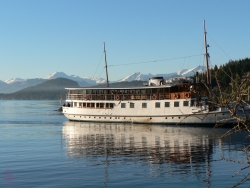Argentina
Argentina for the Independent Traveller
The country and culture of modern-day Argentina is an enchanting
mix of varied nationalities and incredible lands. Visiting
Argentina means preparing to meet with people who are welcoming to
tourists and planning to view such varying sites as icebergs,
deserts, waterfalls, prairies, rivers, lakes and sprawling cities.
Buenos Aires, the Argentine capital, is rather like the Paris of
South America and it offers is own cosmopolitan blend of
hospitality and charm.

Lake Nahuel Huapi at Llao Llao
The lands of Argentina cover roughly 1,073,400 square miles. The
variations of land and climate from region to region make it a
fascinating country to visit. From the inland glacier known as
Perito Moreno in Patagonia to the picturesque Lake Nahuel Huapi in
the Andean lake district, there is something naturally phenomenal
to see. The country is essentially divided into geographical
sections. The Pampa is a flat fertile plain in central Argentina
where agriculture and herding make up the life of this region. The
Pampa is famous for its gauchos, South American cowboys.

Capital: Buenos Aires
Language: Spanish (official)
Time: UTC -2 hrs
Currency: Argentine peso (ARS)
The Andes Mountains sweep up and down along Argentina's western
border. Even today, travel is especially difficult in this area
during winter months when blizzards rage within the valley walls.
South and east of the Andes lies the Patagonia region that is
zigzagged with canyons and rushing water. It had been a barren
region for much of its history, but it has since been cultivated
and produces grapes and produce from its vineyards and orchards.
The northern section of Argentina contains the Chaco and
Mesopotamia regions. Fertile plains and waterfalls such as Iguacu
Falls are the signatures of these regions.
To view the country's native fauna and flora, visitors might
travel to any of Argentina's thirteen national parks. From Jaguars
to yellow-beaked toucans, there is a wide range of animals that are
native to Argentine lands. Llamas and alpacas are common sights in
the Andes regions of the country; Native Americans tamed these pack
animals some four thousand years ago. Mountain sheep are also
readily visible in the mountainous areas. Argentine waters contain
a rich abundance of life. Rivers are filled with trout and bass.
Large sharks, killer whales and sea lions are typical visitors to
Argentine waters.
Buenos Aires attracts flocks of visitors annually. This
international city contains the world's widest street - Avenida 9
de Julio is 425 feet wide. There are many places of interest in
this city such as Recoleta Cemetery where Eva Peron is buried, the
Metropolitan Cathedral, Casa Rosada, Plaza de Mayo, Buenos Aires
Stadium, and the National Museum of Fines Arts. Visitors enjoy
seeing the tango performed at various places in the city as well as
football, or soccer, games.
Argentine cafes are also quite famous and travellers should take
advantage of mingling with the locals who enjoy sipping yerba mate,
coffees and playing chess. Argentine cuisine is meat-based as
Argentina is home to numerous cattle ranches. Beef is the main
faire in the Pampa, but Buenos Aires offers plenty of wonderful
restaurants where tourists can sample all things Argentine.
Visitors to Argentina may also want to visit cities like
Cordoba, Rosario and La Plata. The tip of Argentina is a stormy
area of the world, but the history there makes it a worthwhile
place to see. The country also has many wineries that make
wonderful features to visit. Before visiting Argentina, immerse
yourself in some Argentine history and read some of its authors
like Jorge Luis Borges or Manuel Puig. Be sure to brush up on your
Spanish as that is Argentina's official language. Otherwise, be
prepared for a rich culture and fascinating lands.
